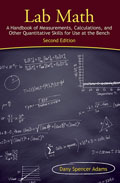Flashy new techniques get a lot of press, sometimes deservedly so: technical breakthroughs often lead to breakthroughs in understanding as well. But in the struggle for game-changing insights and the fame (funding) they bring, the tried, and more importantly true, gets lost in the shuffle. The person who has to teach the intro class is pitied, and it is considered mind numbing or remedial to cover the fundamentals. It is an unchallenged truth that science writing will be terrible. In the more expensive schools undergraduates are using the PCR machine but they don’t know how to calibrate the pH meter. Graduate students are learning to program mathematical modeling software but need an online program to convert units. The fact that Lab Math fills a genuine need is great for me personally, but a sad comment on something. High school science education? Parents confusing “best” with “newest”? Software that claims to perform critical analysis?
I happen to think that advertising is the root of all evil[1]. The word “smart” now applies to phones; need I say more? To sell a product requires convincing a buyer that this product offers something that product does not and you need that thneed[2]. Whether that something is useful or good is rarely discussed and certainly not by the salespeople. Plus we all like shiny new things. New math anyone?
Most of the fundamentals, like multiplying fractions, using a pipet, reading a graduated cylinder, and matching your predicate to your subject, are forgotten in our excitement over ANOVAs and digital qPCR machines and telling everyone what we did. Perhaps it should be reasonable to assume that students got those fundamentals in high school, grade school, or utero. Unfortunately we make that assumption at the peril of our experiments. The wrong pH can really mess you up and it will be almost impossible to discover what went wrong or, worse, that something did go wrong. Even if your students took the classes and aced the tests, it is likely that the skills were forgotten, or deemed useless, before your student realized that Science was the best career on the planet. Plus the students, especially the A students, either don’t know they don’t know[3], or won’t admit they don’t know. Students are often embarrassed to ask how to use the tools, or they assume they don’t need to ask. So everyone thinks they know how to pipet and how to write, and here we are, publishing p-levels while leaving out the sample size, the effect size, and the power, and reviewing manuscripts that take forever to read because the writer’s meaning is so well hidden. The public doesn’t have a chance and science writing is now a specialty that, while it is well written, often garbles some of the facts, or misses the important ones. And I know good scientists who don’t know that an outlier is not just something that looks different, there is an actual calculation involved[4].
My suggestion is that everyone, regardless of whether they believe it to be true, announce: “I do not write, or measure, or calculate as well as I could.” Spend time with your students actually reading the manuals of your tools before using them – even pipettes have directions. Have a journal club in which you read The Science of Scientific Writing by Gopen & Swan[5] and Strong Inference by Roger Platt[6]. Work through Biostatistics: the Bare Essentials or PDQ Statistics by Norman and Streiner[7]. That knowledge is the foundation you must have, and maintain, so that you can build a new paradigm with your creativity and your novel insights. And the students will really appreciate being taught stuff without having to ask. Do this for the whole field: work on your writing and your arithmetic skills. Help put Lab Math on the remaindered list.
[1] The irony of that sentence appearing on a blog that is, at least in part, advertising for my book, has not escaped my notice.
[3] See: Kruger J. and Dunning D. (1999) Unskilled and unaware of it: how difficulties in recognizing one’s own incompetence lead to inflated self-assessments. Pers. Soc. Psychol. 77(6):1121-34.
[4] I will take this opportunity to say how delighted I am to see box plots again!
[5] Gopen G. and Swann, J. (1990) The Science of Scientific Writing. American Scientist. https://www.americanscientist.org/issues/pub/the-science-of-scientific-writing
[6] Platt, J.R. (1964) Strong Inference. Science. 146:3642. http://pages.cs.wisc.edu/~markhill/science64_strong_inference.pdf
[7] Norman, G.R. & Streiner, D.L. (2014) Biostatistics: The Bare Essentials 4th ed. Hamilton, Ontario, Canada. B.C. Decker Inc. –OR– Norman, G.R. & Streiner, D.L. (2003) PDQ Statistics, 3rd ed. Hamilton, Ontario, Canada. B.C. Decker Inc.

Discussion
No comments yet.